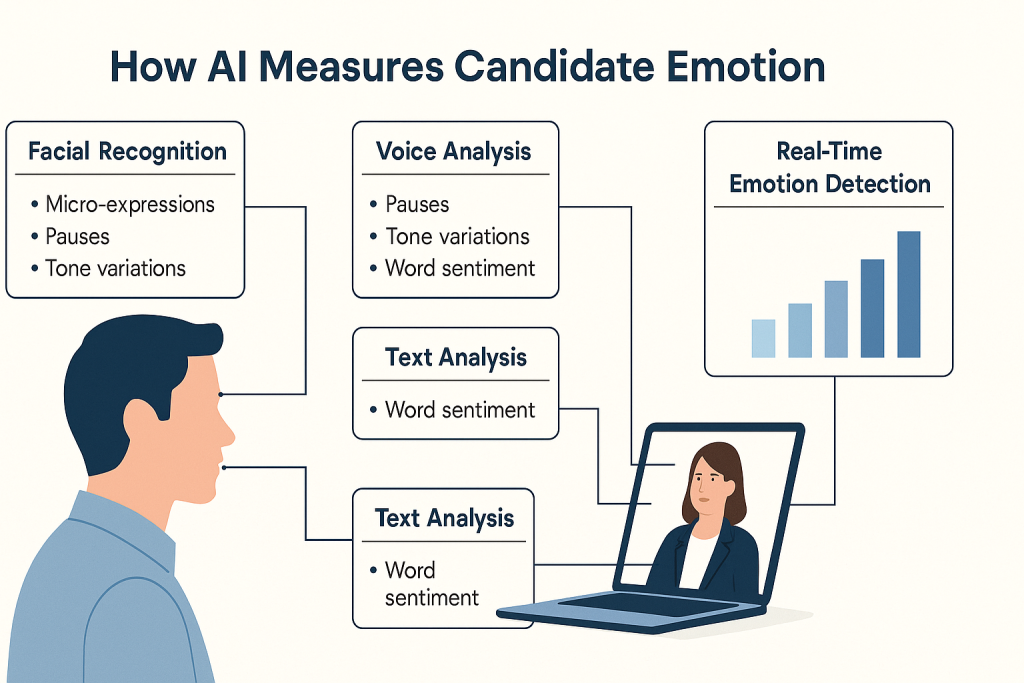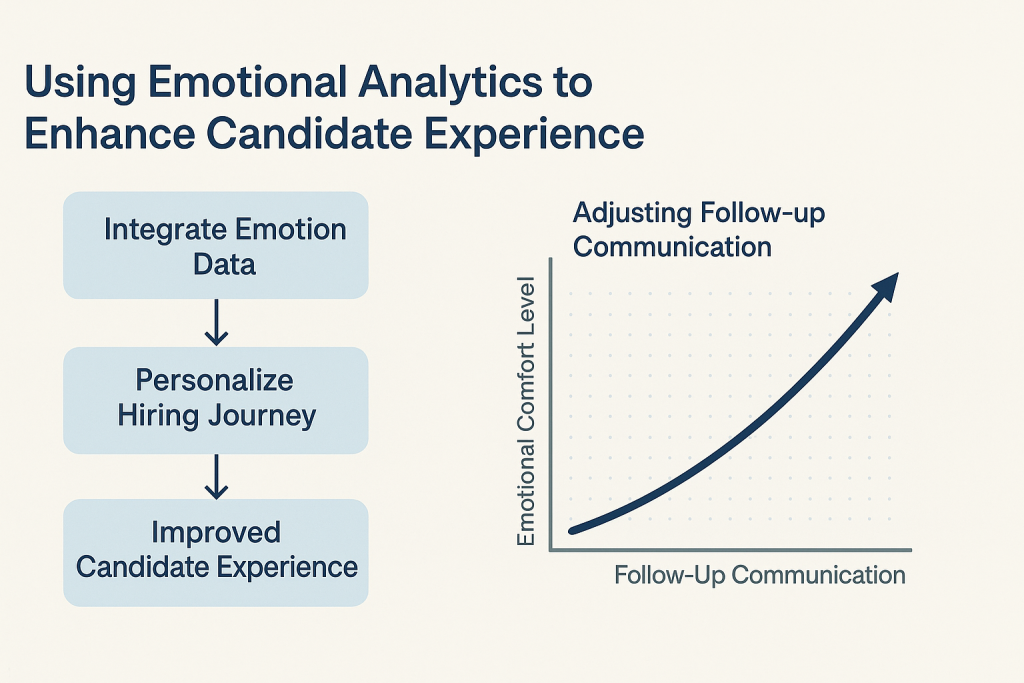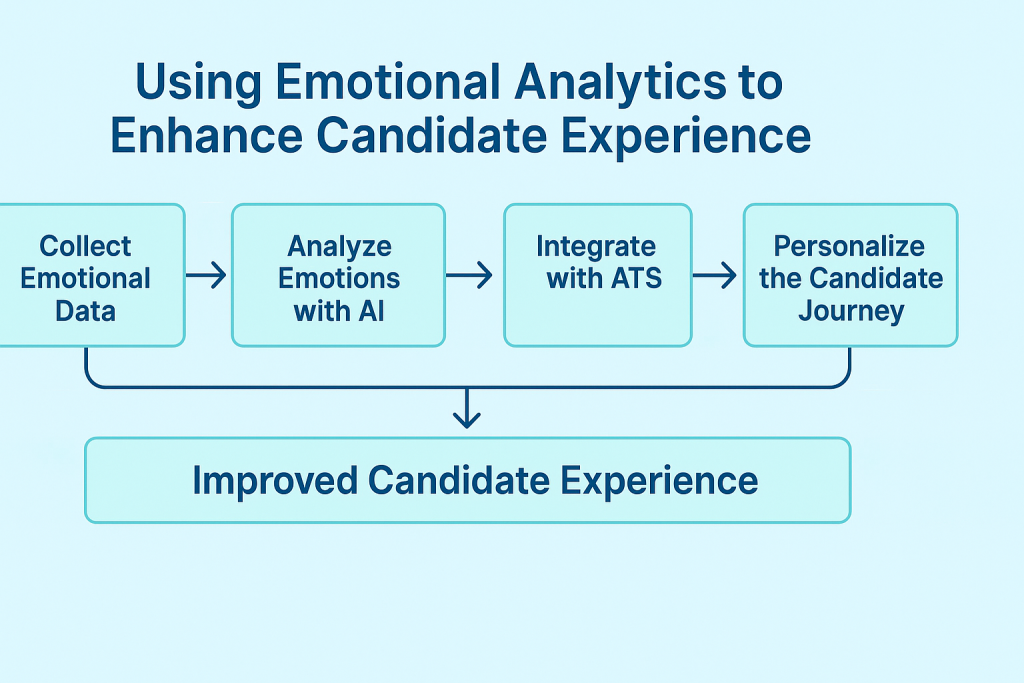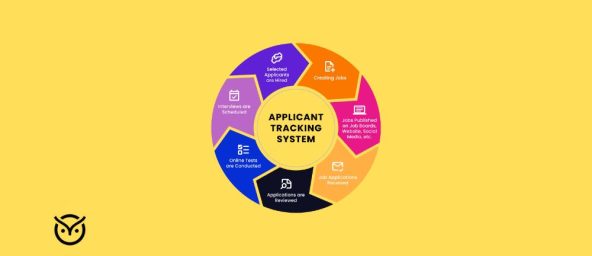
TL;DR
- Emotional analytics uses AI to read candidates’ emotions
- AI recruitment solutions improve candidate experience
- Understanding emotions helps recruiters reduce bias, improve interview quality, etc.
- Emotional analytics is shaping the future of hiring, enhancing candidate experience with AI
Understanding how AI recruitment solutions improve candidate experience is becoming a competitive advantage and not a luxury. You could actually understand how candidates feel during interviews—whether they are calm, tense, or uncertain- and then use that understanding to make the experience smoother for them. That is the role of emotional analytics.
In this blog, you’ll learn how AI reads emotions, why they matter in recruitment, and how tools like Vettio’s platform help recruiters enhance candidate experience with AI in recruiting effectively.
What Is Emotional Analytics in Recruitment?

Emotional analytics means using AI tools to understand human feelings. These tools watch facial cues, voice tone, small gestures, and even the words a person chooses to figure out how a candidate is feeling during an interview.
In recruitment, emotional analytics adds an emotional lens to the hiring process. It allows recruiters to understand beyond what’s said to sense hesitation, confidence, or enthusiasm. This isn’t about reading minds; it’s about reading patterns.
Companies today are using platforms like Vettio to effectively measure candidate experience, providing insights into emotional reactions during video interviews and assessments. Learning how to measure candidate experience with Vettio helps teams pinpoint friction points that affect a candidate’s comfort and engagement.
Why Candidate Emotion Matters?
According to the Talent Board’s 2023 Candidate Experience Benchmark Research, more than half of candidates share negative recruiting experiences publicly. On the flip side, those who feel respected and understood are 80% more likely to apply again or refer others.
This emotional ripple effect impacts employer branding and hiring success. A single poor experience can affect hundreds of future applicants through social media and word of mouth. When companies use AI recruitment solutions to improve candidate experience, they can detect discomfort early and fix it. Maybe an interviewer’s tone sounded intimidating, or a question created visible stress. AI helps identify those triggers.
Emotion drives perception. A candidate who feels anxious due to cold or robotic interview processes may perform below their actual capability. Measuring and addressing emotional feedback can enhance hiring by personalizing the candidate experience and creating a more natural, fair evaluation environment.
Emotional analytics allows recruiters to detect emotional cues that explain behaviour during interviews. This makes it easier to enhance candidate experience with AI in recruiting and build a reputation for fairness and empathy.
How AI Measures Candidate Emotion

Emotional analytics involving AI uses advanced data science, facial recognition and voice pattern analysis. It measures micro-expressions, pauses, variations in tone and word sentiment to gauge emotions in real-time.
For example, platforms like Vettio analyse the reactions of candidates during digital interviews to detect levels of engagement and stress. Understanding how to measure candidate experience effectively helps organizations to refine interview design, like adjusting time limits or changing the tone of the questions, to reduce the anxiety of the candidates.
Machine learning models are trained on diverse datasets of emotional data to ensure neutrality and minimize cultural bias. The best systems combine video, audio, and text signals for a 360-degree emotional read.
Benefits of Emotional Analytics
1. Improved Candidate Experience
Emotional analytics allows recruiters to see beyond responses and tailor experiences. Using Vettio’s solutions, recruiters can enhance the candidate experience through its platform by detecting stress signals and improving interviewer empathy. It’s not about judgment, it’s about understanding.
A recruiter who notices subtle stress signs can change tone, add reassurance, or explain the process better. That small shift transforms the entire candidate perception. Emotional insight turns a tense interview into a human conversation.
2. Fair and Bias-Reduced Hiring
Traditional interviews often reward confidence over competence. Emotional data helps balance that. By tracking reactions, companies can identify moments where interviewers unintentionally pressure candidates, helping to boost hiring success with insights into candidates, ensuring evaluations are driven by skill and sincerity, not confidence theater.
When emotional analytics is paired with structured assessment methods, recruiters can measure genuine reactions instead of relying solely on impressions, helping enhance hiring with candidate experience personalization that benefits diverse candidates.
3. Better Hiring Outcomes
When recruiters know what motivates or stresses a candidate, they make smarter choices. According to IBM’s HR Analytics Report, organizations using emotion-based analytics saw a 23% improvement in candidate retention.
The insight goes beyond hiring; it helps managers tailor onboarding and engagement plans for new hires. That’s why emotional analytics is fast becoming one of the top tools to enhance candidate experience in recruiting globally.
4. Deeper Interview Insights
Emotional analytics uncovers hidden signals. For example, top interview questions to ask candidates with Vettio can be paired with emotion analysis to reveal how different questions impact candidate comfort and openness.
5. Cultural Fit Assessment
Recruiters can understand how a candidate might fit within a team by noticing emotional patterns. Someone steady and cooperative may feel right in a consultative sales role, while a more expressive and energetic style could suit marketing or creative work.
Using Emotional Analytics to Enhance Candidate Experience

Integrating emotional data with AI recruitment solutions to improve candidate experience allows recruiters to personalize every step of the hiring journey. Imagine tailoring follow-up communication based on emotional comfort levels or adjusting interview tone based on detected anxiety.
How Vettio enhances candidate experience effectively is by merging emotional data with ATS systems to provide a single, holistic candidate view. Recruiters can then design empathy-driven processes that resonate better with candidates’ expectations.
In remote hiring, emotional data becomes even more valuable. Video interviews can feel impersonal, but when AI senses engagement drops or frustration spikes, recruiters can intervene promptly.
This proactive approach helps enhance candidate experience with AI in recruiting and build lasting trust.
This personalized touch turns stressful interviews into engaging conversations, enhancing candidate experience with smart hiring techniques that build trust.
How Emotional Data Is Used by Recruiters Effectively

Alongside data evaluation, recruiters also decipher the results of emotional analytics. For example, top interview practices for effective talent assessment now combine skill testing with emotion analysis to ensure fairness and balance.
Giving effective interview feedback becomes easier when recruiters understand how a candidate felt at each stage. Instead of generic feedback, they can share actionable, human-centered insights, like noting that the candidate seemed anxious about technical questions but engaged during problem-solving.
Recruiters who use top tools to enhance the candidate experience often see stronger relationships and higher offer acceptance rates because they focus on both performance and awareness.
Future of AI in Recruitment: Smarter, Kinder Hiring

Emotional analytics is a move towards hiring that focuses more on people. As AI continues to advance, these systems will not just be measuring what candidates say but also understanding how they say it. This overall enhances candidate experience with AI in recruiting more genuinely.
Emotional analytics depicts a shift towards human-centered hiring. With AI evolving, systems will not just be measuring what candidates say but also understanding how they say it. This enhances candidate experience with AI in recruiting more genuinely.
Deloitte’s 2024 Human Capital Trends Report, 62% of recruiters believe emotional AI will become a standard part of recruitment by 2026. The focus will move from screening resumes to understanding people, creating experiences that are both data-driven and emotionally intelligent.
Conclusion
Recruitment is no longer about who fits the job description best; it’s about who feels right for the team. Emotional analytics helps recruiters combine data and empathy, transforming interviews into meaningful connections. With AI recruitment solutions to improve candidate experience, hiring becomes brighter, fairer, and more human.
Companies using emotional analytics today are already seeing better engagement, higher offer acceptance, and stronger retention. It’s clear that emotion, once the missing piece in recruitment, is now becoming the most important one.
FAQs
Q1. Can emotional analytics help reduce bias in hiring decisions?
Yes. Emotional analytics helps recruiters recognize moments of bias during interviews and supports a fair assessment.Q2. What are the ethical concerns of using emotional analytics to assess candidates’ feelings during recruitment?
Privacy, consent, and data protection are key concerns. Companies must ensure transparency about how emotional data is used.Q3. How accurate are AI-driven emotional analytics platforms at detecting candidate stress or anxiety in interviews?
Most leading systems achieve 85–90% accuracy when calibrated with diverse datasets.Q4. Can emotional analytics predict whether a candidate will be a good cultural fit?
It helps identify emotional patterns that align with company culture but should complement, not replace, human judgment.Q5. What types of data do emotional analytics tools analyze to measure candidate emotions?
They study facial expressions, voice tone, speech pace, eye movement, posture, and word patterns. These signals help show stress, confidence, calmness, or hesitation.Q6. How do candidates typically feel about being analyzed for their emotions during job interviews?
Some candidates feel curious and open. Others may feel unsure or watched. Clear communication helps reduce stress and build trust.Q7. How do companies ensure fairness when using emotional analytics in hiring?
They share what data is being collected and avoid judging based on one signal. Human interviewers still make the final decision.Q8. How do recruiters interpret emotional analytics results alongside other assessment data?
The emotional data supports other insights. Skills, experience, and interview responses remain the main decision factors.Q9. How do emotional analytics platforms integrate with existing applicant tracking systems?
Most platforms connect through plugins or data share tools so insights appear in the same recruiter dashboard.Q10. How do emotional analytics tools protect candidate privacy and data security?
They store data securely and limit access to the hiring team. Candidates should be informed how their data is used and stored.Q11. Can emotional analytics help reduce employee turnover by improving hiring decisions?
Yes. It helps match people to environments where they feel comfortable, which encourages longer retention.Q12. How do emotional analytics tools adapt to remote or video-based interviews?
They analyze facial and voice cues through camera and microphone, providing similar insights as in-person interviews.




